Structured interview – Application
Structured interview incorporates
- multiple raters;
- common questions;
- standardized evaluation procedures (Stewart & Brown, 2019, p. 220);
- predetermined scoring methods.
Types of structured interview
- situational (a candidate responds to a hypothetical situation);
- behavioral (analyzes an applicant’s behavior in past situations) (Stewart & Brown, 2020).
A structured interview is a common interview technique used by HR managers. A structured interview is an “employment interview that incorporates multiple raters, common questions, and standardized evaluation procedures” (Stewart & Brown, 2020, p. 220). The method requires the presence of several raters during the interview rather than a single manager. The rating panel involves standardized scoring methods and provides feedback for each applicant in the form of a numerical score. The range of common questions aims to determine whether the applicant possesses skills and experience crucial for the company’s success. Structured interviews can be divided into two types: situational and behavioral. The situational interview is focused on hypothetical situations presented to an applicant, while behavioral interview analyzes a candidate’s behavior in past situations (Stewart & Brown, 2020). Both types of structured interviews might be used by HRM for obtaining responses that accurately reflect candidates’ abilities and represent their job performance.

Structured interview – advantages
The strengths of structured interviewing
- provides fair and equal assessment of candidates by HRM;
- ensures appropriate and non-discriminatory topics;
- helps to avoid legal issues related to discrimination (Stewart & Brown, 2020);
- increases reliability and accuracy of evaluation (Roulin, 2017);
- prevents interviewers’ subjectivity and promotes validity of assessment (Cascio & Aguinis, 2018).
The method of the structured interview has its advantages and disadvantages. On the one hand, structured interviewing ensures that candidates receive a fair and equal assessment by HRM as applicants respond to the same set of standardized questions. Thus, the structure might decrease differences between racial or ethnic groups by providing an equal evaluation for all candidates. Moreover, since the questions are prepared in advance, the interviewers can ensure that the topics are appropriate and non-discriminatory, which helps to avoid potential legal issues related to discrimination (Stewart & Brown, 2020). The usage of rating panels contributes to the increased reliability and accuracy of evaluation and facilitates the interviewer’s recollection of multiple interview results (Roulin, 2017). Additionally, structured interviews are considered more valid compared to the unstructured assessments that I will discuss further (Cascio & Aguinis, 2018). The validity of the structured method might be explained by its ability to identify the interpersonal, organizational, and professional skills of a candidate via specific job-related questions. Finally, the panel interviewers prevent subjectivity, which is often present when a single manager conducts the interview.
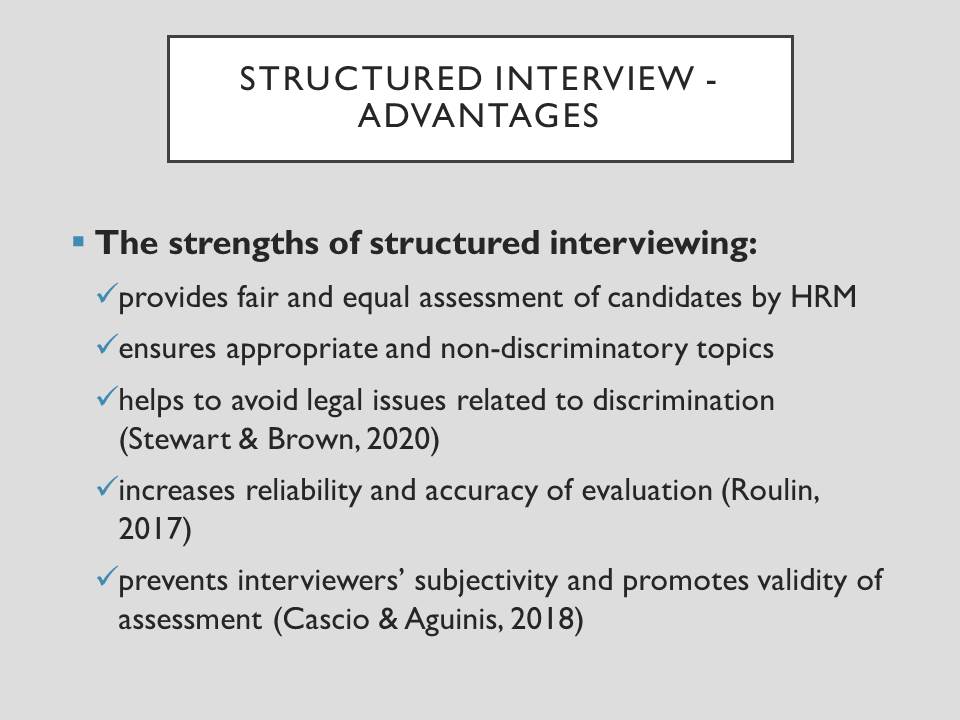
Structured interview – disadvantages
The limitations of structured interviewing
- lacks flexibility;
- expensive and time-consuming;
- interviewers may unconsciously impact the responses of a candidate and the validity of the assessment (Chapman, 2017);
- closed–ended questions restrict applicants’ ability to express themselves.
On the other hand, the method has its flaws and limitations. Since the questions are predetermined and identical for all applicants, the technique lacks flexibility, which would allow the manager to learn more about the candidates. Additionally, structured interviewing is an expensive and time-consuming method because the manager has to spend a substantial amount of time interviewing each candidate face-to-face. Some interviewers may unconsciously impact an applicant’s responses through their facial expression or tone of voice, which may negatively affect the validity of the assessment (Chapman, 2017). Moreover, as the interviewers only use closed-ended questions, the applicants do not have the opportunity to explain why they acted in a particular way in a given situation during a behavioral or situational interview.
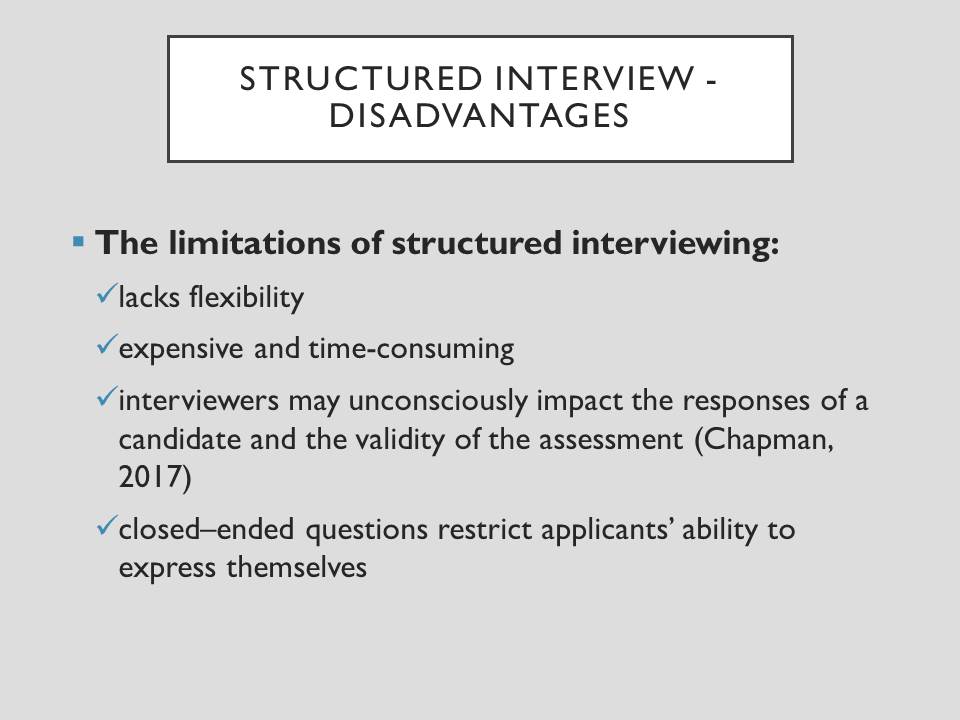
Unstructured interview – Application
Unstructured interview incorporates
- absence of structure;
- features of an informal conversation;
- free choice of open-ended questions (Chapman, 2017);
- lack of standardization and a variety of topics (Bailey, 2018);
- no time restrictions.
The unstructured interviewing technique involves a series of questions asked by a single interviewer to access a candidate and decide whether he or she is suitable for a particular job position. As the interview method does not require a specific structure, the choice of questions depends on an interviewer. The unstructured interviewing is similar to an informal conversation, as the interviewer asks open-ended questions offering the candidate flexibility in choosing a response (Chapman, 2017). The method does not require standardization, which gives the interviewer the freedom to ask questions covering a variety of topics, not necessarily related to a job position (Bailey, 2018). During an unstructured interview, the interviewer’s questions vary depending on an interviewee’s features. One interview might be as short as a few minutes, while another might take significantly more time. Overall, an unstructured interview is not a strict list of limited topics and questions prepared in advance, but an evolving conversation covering diverse aspects of a job position and an interviewee’s character.
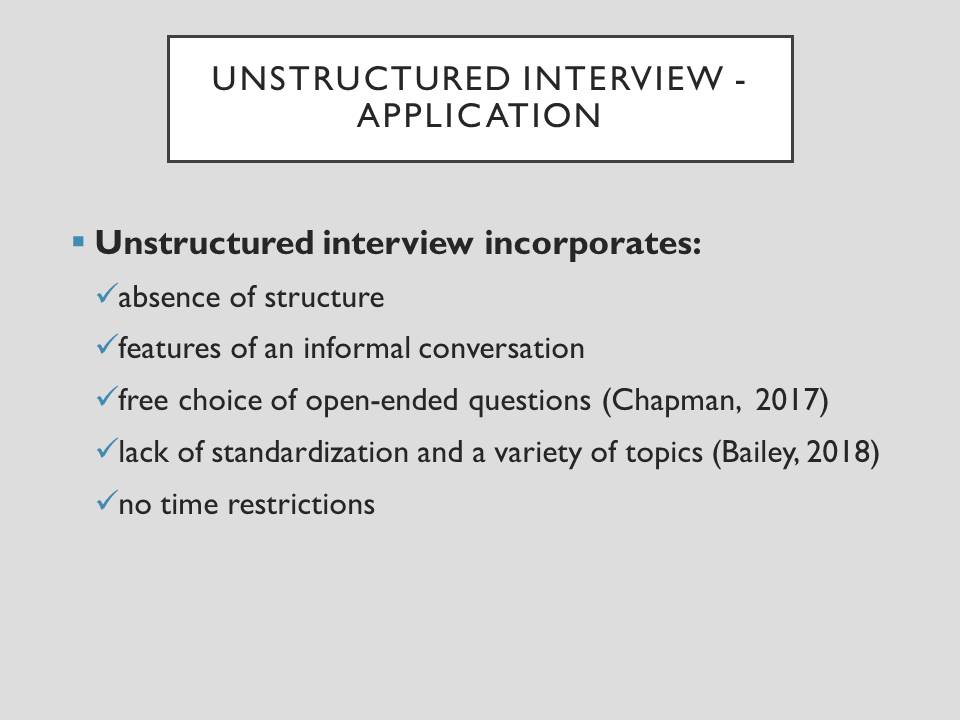
Unstructured interview – advantages
The strengths of unstructured interviewing
- offers flexibility;
- may lead to unexpected findings about the candidate (Chapman, 2017);
- allows the interviewer to learn more about his/ her abilities as a manager;
- provides valid information;
- helps to establish rapport and trust between the participants.
The technique of unstructured interviewing has a number of strengths. Firstly, unlike structured interviewing, the unstructured method is very flexible, as it is not based on a set of predetermined questions, but rather follows the conversation between the interviewer and the applicant. Secondly, the technique may lead to unexpected findings about the candidate, which cannot be discovered if closed-ended questions are utilized (Chapman, 2017). Thirdly, the method allows the interviewer to learn more about his/ her abilities as a manager as it supports a free-flowing conversation and feedback from an interviewee. Finally, unstructured interviews are likely to provide valid information as the interviewer’s involvement in the conversation helps to establish rapport and trust between the participants.

Unstructured interview – disadvantages
The limitations of unstructured interviewing
- not as reliable and valid as a structured method (Stewart & Brown, 2020);
- undetermined amount of time needed for an interview;
- involves the risk of raising an offensive or discriminatory subject;
- allows the interviewer to make decisions based on an applicant’s characteristics unrelated to a job.
Despite the variety of advantages mentioned above, the technique has multiple disadvantages. According to Stewart and Brown (2020), even though HR managers often prefer this method interviewing, “unstructured assessment is not as reliable and valid as more-structured interviews” (p. 220). However, it is possible to correct the drawback if several interviewers combine the results of their assessments to provide a comprehensive and unbiased evaluation. Another disadvantage of the unstructured method is the risk of an employer to be challenged in court for discriminatory practices. The amount of time required for the unstructured interview may not be estimated in advance, as it depends on a candidate’s individual characteristics. As the unstructured interview questions are not standardized or predetermined, the interviewer might accidentally raise an offensive or discriminatory subject. The unstructured method allows an interviewer to make decisions based on an applicant’s characteristics such as goals, interpersonal skills, or physical attractiveness, unrelated to the qualifications needed for a job (Stewart & Brown, 2020). Thus, the unstructured technique might be successfully used for interviewing if its advantages and disadvantages are taken into consideration by HRM.
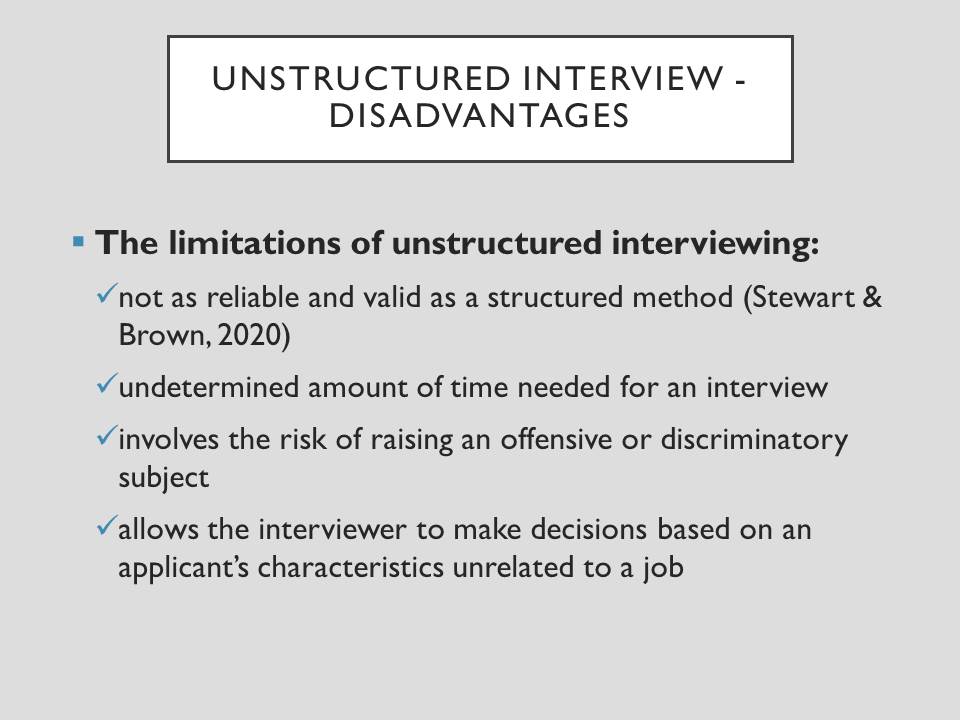
Video-based interview – Application
Unstructured interview incorporates
- the absence of structure;
- assessment in the form of video calls, conferences, and video-recorded resumes;
- the use of applications such as Skype, FaceTime or Google Hangouts (Bailey, 2018);
- no direct interaction with the manager.
The video-based interview technique might be used when the applicant and the employer are located in different cities or countries, which is a common situation in an increasingly globalized business world. A number of easily accessible and free applications such as Skype, FaceTime, or Google Hangouts allow HSM to make video calls and organize video conferences with interviewees (Bailey, 2018). Video calls and conferences might be considered a worthy alternative to a more conventional face-to-face interview. They give the interviewer the same ability to evaluate a candidate’s qualifications, skills, and abilities.
A video resume is a type of video-based interviewing which involves a pre-recorded presentation of an applicant. Video resume gives candidates an opportunity to express their personalities and describe their skills and qualifications in more detail compared to a traditional resume format. During video-recorded interviews, the applicants do not have a real-time interaction with the manager. Instead, they are required to “log in to a secure online platform and are asked to read and answer a series of interview questions” (Roulin, 2017, p. 158). As the technology is constantly evolving, some organizations are developing the algorithms that will allow the applicants’ video responses to be automatically analyzed by a computer (Roulin, 2017). Thus, the video-based method has the potential to be used by HRM of multiple companies in the future.
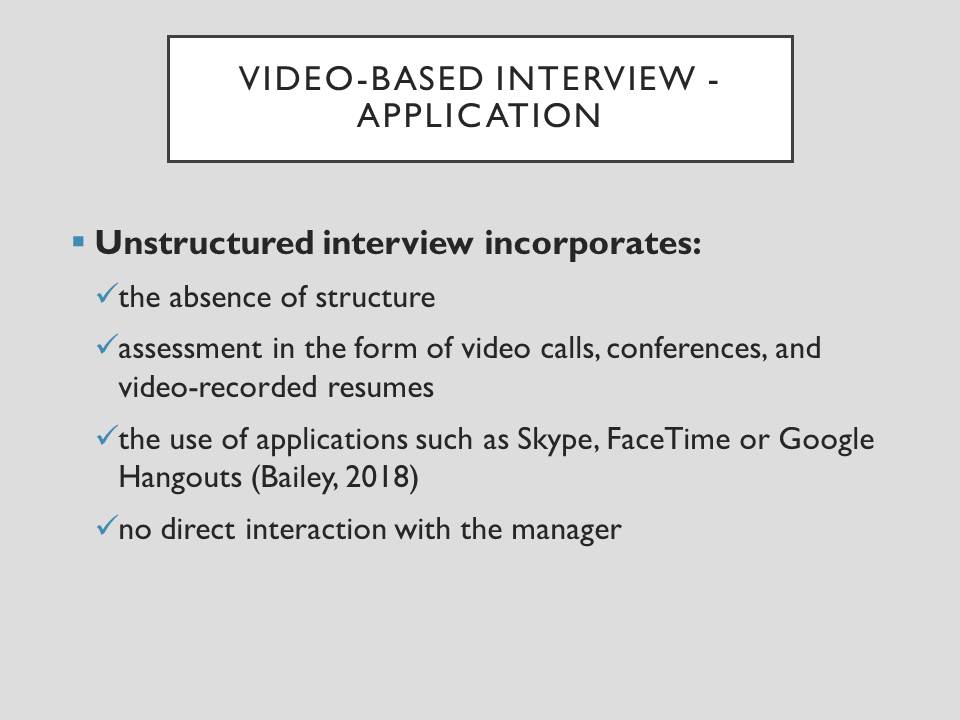
Video-based interview – advantages
The strengths of video-based interviewing
- combines the advantages of both structured and unstructured methods;
- provides eye contact between the interviewer and the candidate (Bailey, 2018);
- offers flexibility;
- equal and non-discriminatory evaluation of applicants.
The video-based technique demonstrates plenty of advantages as it combines the characteristics of both structured and unstructured interviews as well as the benefits of remote communication. Similar to traditional face-to-face interviews, the video-based method provides eye contact between the interviewer and the candidate, which is important for an effective assessment of interviewees (Bailey, 2018). Like the unstructured method, the video-based technique offers more flexibility, as the interviews can be held or recorded from any part of the world and accessed by managers in real-time. Video-recorded interviewing has the advantages of the structured method, as it involves standardized questions set in the fixed order and ensuring equal and non-discriminatory evaluation of all candidates regardless of their background (Roulin, 2017). Video-based interviews are relatively simple as they only require a stable internet connection and can be performed using a smartphone or a computer.

Video-based interview – disadvantages
The limitations of video-based interviewing
- “access to less information and less opportunities for rapport-building” (Roulin, 2017, p. 157);
- rarely used to make final decisions;
- expensive and time-consuming when used for screening purposes;
- prone to technical issues (slow connection, application crashes).
Like any other technique, video-based interviewing has its flaws. Roulin (2017) claims that during video-conference interviews, the HR manager has “access to less information and less opportunities for rapport-building”, which might negatively affect the quality of a candidate’s evaluation (p. 157). Video-recorded interviews are rarely used to make final decisions as they are considered as screening tools rather than adequate and complete instruments for candidate evaluation (Roulin, 2017). Thus, the technique should be followed by an actual face-to-face interview, which makes the video-based method expensive and time-consuming when used for screening purposes. Additionally, video-based interviewing tools are prone to technical issues such as slow connection or application crashes, which may cause anxiety and irritation in some applicants and interviewers. Such problems, however, can be averted if regular technical diagnostics are performed by the company’s IT specialist.
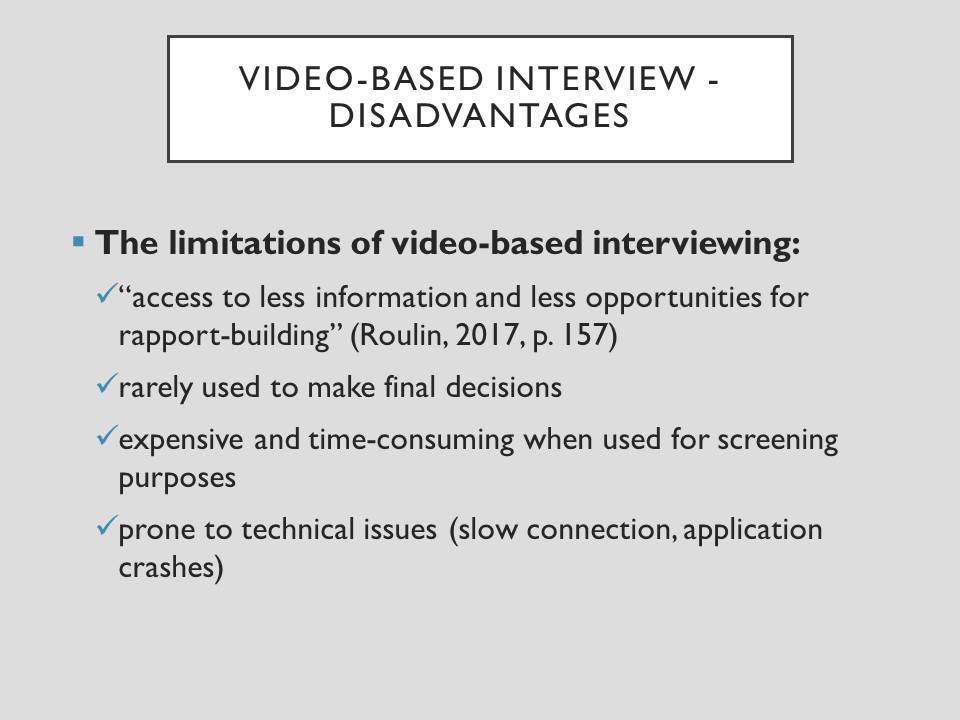
Possible legal issues
Documents prohibiting employment discrimination
- Title VII of the Civil Rights Act of 1964 evaluation of information;
- the Age Discrimination Employment Act of 1967;
- Americans with Disabilities Act of 1990 (SHRM, 2020, “Legal Issues”).
Topics to avoid during an interview
- age;
- gender;
- race;
- ethnic or national origin;
- religion;
- disabilities.
There are several federal laws and regulations that might affect the interviewing process and the selection of questions. Title VII of the Civil Rights Act of 1964 prohibits discrimination “based on race, sex, color, national origin and religion”, while the Age Discrimination Employment Act of 1967 bans age-related questions (SHRM, 2020, “Legal Issues”). Additionally, Americans with Disabilities Act of 1990 provides protection for qualified job candidates with disabilities (SHRM, 2020, “Legal Issues”). Therefore, to avoid discrimination lawsuits, the interviewer should be aware of the topics that cannot be discussed during the employment interview. Such topics include a job candidate’s age, gender, race, ethnic or national origin, religion, and disabilities. Avoiding the questions related to the topics listed above might help to prevent legal action against the employer. All in all, HR specialists should clearly determine their goals and business strategy in order to choose a suitable interview method for recruiting efficient and loyal employees.

References
Bailey, C. A. (2018). A guide to qualitative field research (3rd ed.). SAGE Publications.
Cascio, W. F., & Aguinis, H. (2018). Applied psychology in talent management (8th ed.). SAGE Publications.
Chapman, S. (2017). My revision notes: OCR A Level sociology. Hodder Education.
Roulin, N. (2017). The psychology of job interviews. Routledge.
SHRM. (2020). Interviewing candidates for employment. Web.
Stewart, G. L., & Brown, K. G. (2020). Human resource management: Linking strategy to practice (4th ed.). Wiley.